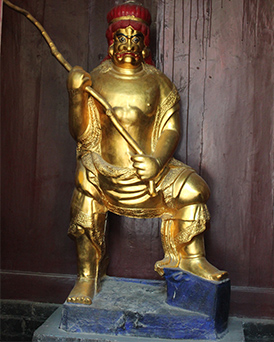Shaolin Kungfu Monk Corps’s predecessor was Shaolin Warrior Monks. In the reign of Tang emperor Li Shiming (598-649 A.D), indebted to the thirteen monks for saving his life, the emperor granted the privilege of owning warrior monks to Shaolin Temple.
[Detail]Shaolin Kungfu refers to the traditional cultural system that has formed in the particular Buddhist cultural environment in Shaolin Temple of Songshan Mountain over long history. It is based on a belief in the supernatural power of Buddhism and fully reflects the wisdom of Chan Buddhism. The martial arts practiced by monks in the Shaolin Temple are its major form of expression.
[Detail]2018-04-03
2024-10-18
2023-12-23
2023-11-30
Henglin (1865-1923) was a noted Shaolin Kungfu monk and Chan master in the late Qing Dynasty and the early Republic of China. He took tonsure in Shaolin Temple and delved into Kungfu practices. Owing to his proficiency in Kungfu, Henglin was appointed as the instructor of Kungfu monks. In the turmoil of war during the early Republic of China, Henglin led a warrior monk group and defeated bandits in Shaolin areas. He was commended and awarded with medals and inscriptions presented by authorities.
Yuekong was a noted Kungfu monk during the Ming Dynasty. Ancient records show that Shaolin Kungfu monk Yuekong received an official call to fight against pirates in the southeastern coastline. He led a troop of 30-plus warrior monks and defeated a lot pirates, but died in an ambush to save captives taken by pirates. Their story has been written in the history of Shaolin warrior monks’ fight against pirates.
Xiaoshan (1500-1568) was one of great Chan masters during the Ming Dynasty. Before he took the position as Shaolin Abbot, he had studied with previous abbot Yuezhou for eight years and preached Chan Buddhism at numerous monasteries. Xiaoshan was inaugurated as abbot in 1557 by an edict of the imperial court. As the abbot of Shaolin Temple, he presided over large Dharma gatherings to rejuvenate the Caodong School at Shaolin Temple, and also raised funds to renovate the temple and rebuild the First Patriarch Temple. During the fight against pirates in the Ming Dynasty, Shaolin warrior monks dispatched by then Abbot Xiaoshan defeated the pirates at several battles and enjoyed popular acclaim for their victorious achievements. Xiaoshan retreated from his position in 1566 and passed away at age 68 in 1568.

No biographical information on Kinnara is available. One story from ancient Mt. Song records tells that in 1341 an eccentric monk with a stick unexpectedly appeared and then served at the temple kitchen. The monk defended the temple against the attack of the red turbans on March 26, 1351(Yuan Dynasty) and was then found out an incarnation of King Kinnara. Thereafter, Kinnara was revered as the guardian deity of Shaolin Temple. A Kinnara Hall was built and his statue enshrined inside.